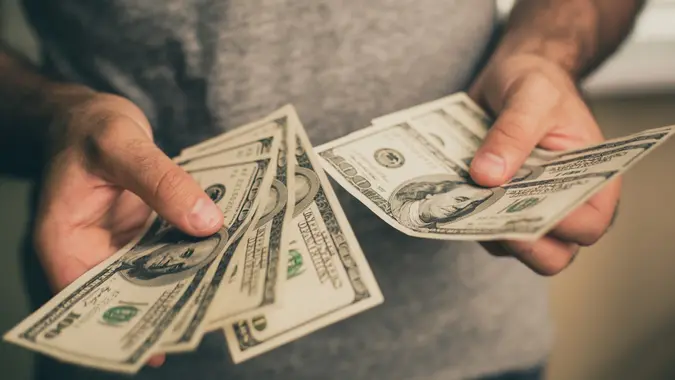Student Loans, Rising Debt and 4 Other Curveballs That Could Contribute to Economic Collapse in 2023

Commitment to Our Readers
GOBankingRates' editorial team is committed to bringing you unbiased reviews and information. We use data-driven methodologies to evaluate financial products and services - our reviews and ratings are not influenced by advertisers. You can read more about our editorial guidelines and our products and services review methodology.

20 Years
Helping You Live Richer

Reviewed
by Experts

Trusted by
Millions of Readers
The U.S. economy keeps defying expectations of a looming recession, growing just enough to calm the nerves of investors and consumers but not quite enough to end talk of a possible collapse. Some experts warn that a collapse could happen sooner rather than later due to a convergence of factors ranging from the resumption of student loan payments to rising oil prices.
First the good news: The country’s real gross domestic product rose at an annual rate of 2.1% in the 2023 second quarter after increasing 2.0% in the first quarter, according to the U.S. Bureau of Economic Analysis.
Ahead of this week’s Federal Reserve meeting, The Wall Street Journal noted that “underlying inflation is looking cooler” than the Fed thought, while the economy is “looking much stronger.”
“Absent a reacceleration in core inflation, the Fed’s tightening cycle might be over,” the WSJ stated. “Then again, considering how much stronger the economy has been than they thought, policy makers might also forecast fewer rate cuts next year than they previously saw.”
Despite the economy’s resiliency, not everyone is upbeat about its near-term prospects. As Business Insider reported last week, several risks were mentioned at the recent Fall 2023 Stern Economic Outlook Forum. Here’s a look at six of those risks:
Federal Student Loan Payments Will Resume
Payments are set to resume in October 2023 after a three-and-a-half-year pause that went into effect during the early days of the COVID-19 pandemic. Some experts warn that many borrowers are not financially prepared to resume payments, while others will have to cut back on consumer spending to afford them.
Delinquency Rates are Rising
According to New York Fed data cited by Business Insider, the rate for new credit card delinquency rose to 7.2% in the second quarter of 2023 from 4.8% the previous year. New auto delinquencies climbed to 7.3% from 5.6% over the same time frame, while overall credit card debt continues to spike.
And So Are Oil Prices
Oil prices climbed by more than $1 a barrel early Tuesday (Sept. 19), Reuters reported. This signaled a fourth straight session of gains amid ongoing supply concerns caused by production cuts by Saudi Arabia and Russia. Global benchmark Brent crude futures were up $1.24, or 1.31%, to $95.67 a barrel, while U.S. West Texas Intermediate crude futures climbed $1.92, or 2.1%, to $93.40.
Prices have risen for three consecutive weeks, Reuters noted. This typically leads to higher gasoline and energy prices, which cause consumers and businesses to reduce spending — a bad omen for the economy.
Excess Savings are Dwindling
At last week’s Stern Economic Outlook Forum, Apollo Global Management Chief Economist Torsten Sløk cited San Francisco Fed data showing that U.S. households are running out of the excess savings that built up during the pandemic, Business Insider reported. This is another bad omen for the economy because it shows the impact of inflation on savings, leaving Americans with less of a financial cushion.
Bank Loans are Slowing
Since March, banks have been “stepping fairly hard on the brakes” in terms of loan approvals, Sløk said — a development that is “beginning to have more and more serious consequences.” Bank loans, especially to businesses, are a key factor in economic growth because they allow businesses to expand operations and payroll. When those loans slow down, so does corporate and consumer spending.
Corporate Loan Default Rates are Up
One reason corporate loans might be slowing is that an increasing number of those loans are going into default, Business Insider noted. Sløk pointed to a “significant move higher in default rates” for business loans, partly as a result of higher interest rates and borrowing costs.
“The level of the cost of capital has gone up so much that this is now beginning to have … implications for corporate spending and of course also for consumer spending,” Sløk said.
 Written by
Written by 

























